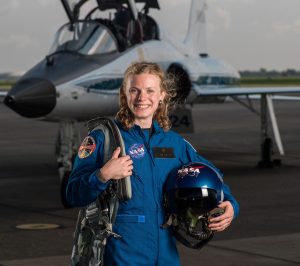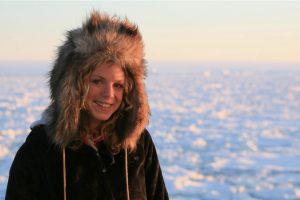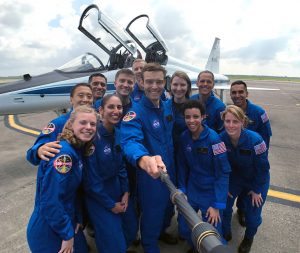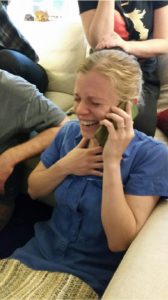
Carolina alumna Zena Cardman is a new NASA astronaut trainee. Over 18,000 people applied to be in the 2017 class; she was one of 12 selected. Photo by Robert Markowitz, NASA.
From the lava fields of Hawaii to the vast expanse of Antarctica, alumna Zena Cardman has ventured to some of Earth’s most remote places. Now she has set her sights on the ultimate frontier — space.
Life-changing moments can come when you least expect them. On a hot August afternoon, Zena Cardman feels her phone buzz and sees a number she doesn’t recognize — an area code from Houston. She hesitates, thinking it might be a marketing call.
She decides to answer it. A woman’s voice says, “Hello, this is the astronaut selection office.” Cardman stands up and starts pacing around the living room. It’s not a marketing call, and it’s not a joke. “We’d like to have you come down to Houston for an interview.”
After a few seconds of stunned silence, Cardman says she would be honored.
Back in January, she had submitted her resume to the NASA Astronaut Candidate Program. “That’s all the application is; there’s no essay to wax poetic about why you want to travel to space,” Cardman says.
She heard nothing for the next nine months. Then, less than two weeks after she received the phone call from Houston, Cardman found herself at Johnson Space Center.
Her first morning there, she walked down a hallway lined with photos from every era of the space program, from Apollo 1 astronauts practicing egress training in a swimming pool to Scott Kelly floating in the cupola of the International Space Station.
“I get shivers every time I walk down that hallway,” Cardman says. “The fact that they even want to consider me for this kind of position is amazing.”
From UNC to world’s edge

During her time at UNC, Cardman went on three expeditions to Antarctica.
A decade before she walked down that hallway at Johnson Space Center, Cardman walked into Coker Hall, home to the biology department on UNC’s campus.
As a first-year student, Cardman fully immersed herself in Carolina’s rich culture of science and discovery. She found particular inspiration in an Endeavors magazine article by another undergraduate student, Kate Harris. “She had also worked in marine sciences and done research in Antarctica,” Cardman says. “I just thought that was so cool.”
When Cardman thinks something is cool, she goes after it full-throttle. “I was dead set on going south,” she says.
Two years later, she did.
—
After four days aboard the Laurence M. Gould, Cardman finally saw the southernmost continent, but it didn’t look like land.
“It looked like clouds on the horizon, like a white haze,” she says. “It’s such a cool feeling — to cross an ocean and see land that you’ve never seen before, land that you’ve never stepped foot on.”
Standing at the edge of the world. Stepping into unexplored territory. That’s what astronauts do. Cardman believes her research experience (she has participated in three expeditions to Antarctica) has a strong correlation to space travel.
“You’re in a remote place with a limited number of people and you’re relying on this ship as your home and your life support,” she says. “You are there to do science. But you have to be just as willing to fix the toilet, clean up, cook, and be part of daily life to keep your lifeboat running.”
Practice for Mars
Seven years later and over 7,000 miles from Antarctica, Cardman displays leadership skills characteristic of the best field scientists. She’s in Hawaii, pretending to be on Mars.
As part of the BASALT (Biologic Analog Science Associated with Lava Terrains) research project, Cardman and her colleagues carry out a simulation for a mission to Mars in Hawaii Volcanoes National Park. Two people play the role of astronauts while Cardman and a group of volunteers run support.

The new recruits take a selfie. (photo courtesy of NASA)
An instrument needs recalibration. An antenna needs to be adjusted. Something simple but essential — like the meter stick used for scale — was left behind and needs to be jury-rigged. Cardman helps rectify those issues. “Field work is a reminder that we’re all human and we’re bound to make some mistakes,” she says.
Going to Mars appeals to Cardman because she is a scientist. “Doing geology on another planet would be amazing,” she says. “But I never really thought about the requirements to direct those scientific investigations. There are logistical roles people have to play — how do you make sure you’re getting good data and good samples when the scientific experts are remote?”
Hawaii. Antarctica. The Arctic. Canada. Italy. The Gulf of Mexico. Virginia. Cardman has collected data and conducted field operations all over the world. It makes sense that she would be adept at doing the same thing on another planet.
More tests, more tasks
Over 18,000 people applied to be in this class of astronauts, and Cardman is one of 50 finalists. She’s in the top 0.3 percent.
After a battery of interviews, medical exams, skills-based simulations, and aptitude tests, Cardman is certain about two things:
“I don’t need to see a doctor any time soon,” she says with a laugh. And she really, really wants to be an astronaut.
—
At the end of May, Cardman receives another phone call; the number with the Houston area code is familiar now. She knew the Astronaut Selection Office would call on the 25th, whether the final answer was yes or no.

When Cardman received the call of a lifetime, a friend was there to capture the moment. (photo courtesy of Zena Cardman)
“I was really, really glad to have a few close friends spend that morning with me, otherwise I would’ve been a mess!” Cardman says. “It was one of the most surreal moments of my life! Honored and overjoyed doesn’t even begin to explain it.”
At just 29 years old, Cardman has accomplished something only the smallest fraction of humans do — becoming an astronaut-in-training.
Zena Cardman graduated from UNC in 2010 with a major in biology and minors in marine sciences, creative writing and chemistry. She was a Carolina Scholar as an undergraduate and also received a Burch Fellowship. She completed her master’s degree in marine sciences at UNC in 2014 and was working toward a Ph.D. at Penn State when she received the call from NASA.
Story by Mary Lide Parker ’10, a writer for Endeavors magazine.
